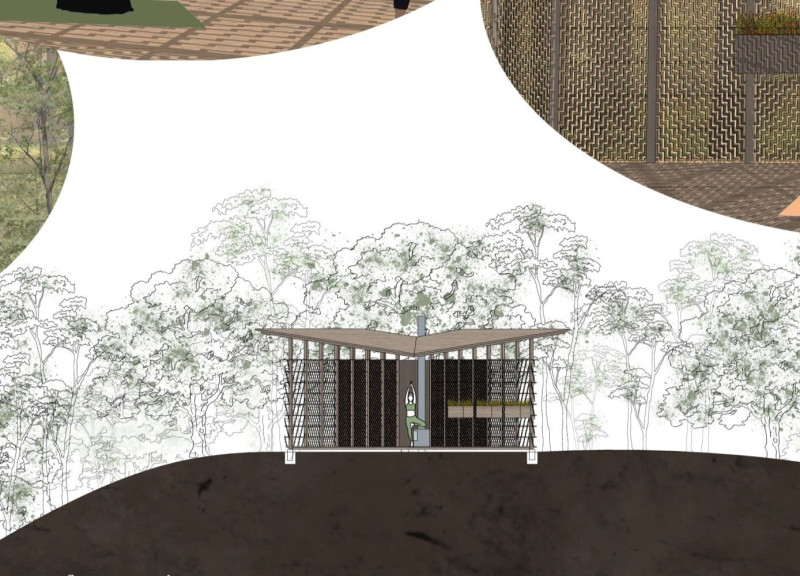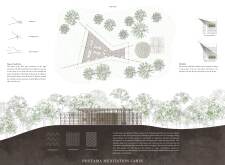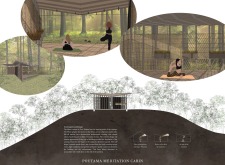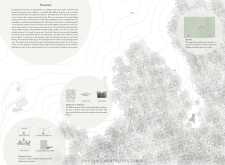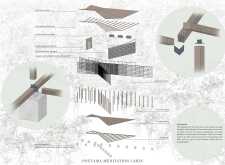5 key facts about this project
The cabin's architectural design features a unique triangular form that creates an inviting space for both individual and communal meditation practices. The arrangement encourages fluid movement through various zones, each tailored to support a different aspect of the meditative experience. Users transition from an entrance that engages with the forest surroundings into a tranquil interior that promotes relaxation and contemplation. The layout thoughtfully guides individuals along a pathway that emphasizes a gradual shift from the outside world into a space of calm, making the journey itself an essential part of the experience.
The Poutama Meditation Cabin functions as a sanctuary for those seeking respite from the complexities of modern life. Its primary use is to provide a dedicated space for meditation, yoga, and other reflective practices. The design prioritizes peace and introspection, fostering an environment where users can connect with themselves and nature in a profound way. Careful attention has been paid to ensure that the space conveys a sense of harmony, aligning with the broader themes of mindfulness and self-discovery.
Several important design elements contribute to the cabin's unique appeal. The use of local wood for structural components reinforces the project's connection to its natural surroundings while promoting sustainability. This choice not only enhances the aesthetic quality of the interior but also ensures that the cabin coexists harmoniously with the forest landscape. Additionally, polycarbonate windows are strategically positioned to let in diffused natural light, enhancing the cabin's atmosphere without compromising insulation.
Another notable feature is the incorporation of Tukutuku panels, which are traditional Maori decorative elements that can be found within the interior design. These patterns infuse the cabin with cultural significance, reminding users of the importance of heritage and communal storytelling. The combination of these indigenous patterns with modern materials creates a dialogue between the past and the present, enriching the overall narrative of the space.
The design incorporates flexible flower holders that can be adjusted according to the sunlight, creating a dynamic environment that evolves throughout the day. This innovative approach encourages users to interact with their surroundings in various ways, enhancing their sensory experience within the cabin. The play of light and shadow, facilitated by the design's perforated wooden panels, evokes a sense of comfort and tranquility, integral to the meditation experience.
The inverted roof design not only serves an aesthetic purpose but also plays a crucial role in rainwater management. This practical consideration reflects a commitment to environmental sustainability, allowing the cabin to function as an integral part of the ecosystem. Users experience a connection with nature as they engage with the structure, highlighting the relationship between built environments and their natural contexts.
As visitors step into the Poutama Meditation Cabin, they encounter a carefully orchestrated space that nurtures mindfulness and self-reflection. The interior is designed to accommodate various meditative practices, whether solo or in groups, while maintaining visual connections to the natural environment. This thoughtful organization supports a multiplicity of experiences, allowing users to engage with both the interior and exterior landscapes seamlessly.
The Poutama Meditation Cabin represents not only a physical structure but also an architectural response to philosophical concepts related to meditation and self-awareness. The integration of local materials, cultural elements, and innovative design approaches showcases a dedication to fostering well-being through architecture. For those interested in gaining deeper insights into this compelling project, exploring the architectural plans, sections, designs, and ideas will reveal the thoughtfulness and intention behind every aspect of the cabin's creation.


